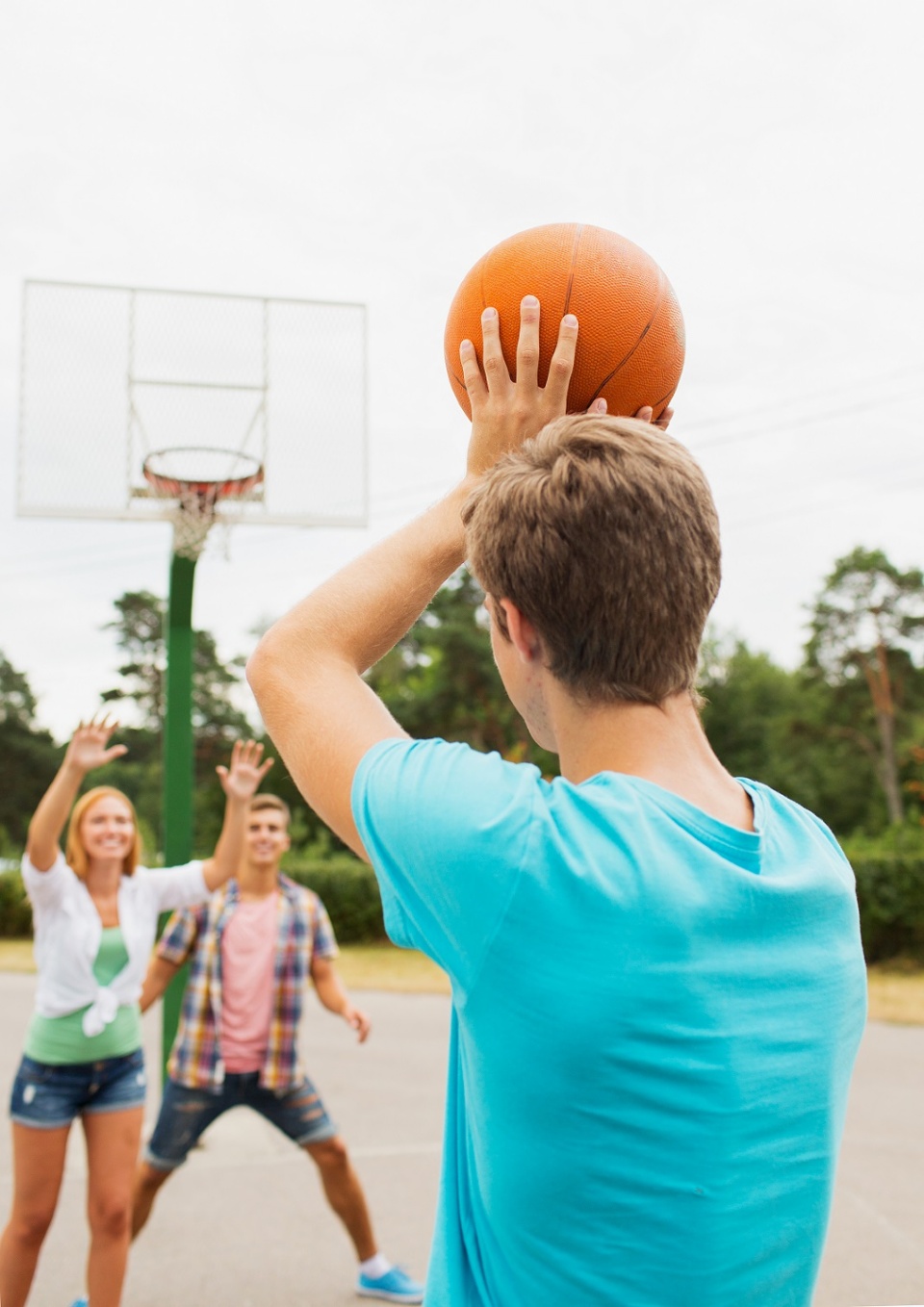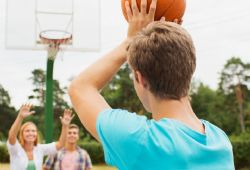As a child, your parents may have signed you up to play a sport,
whether it was soccer, hockey, football, or ballet. What probably never crossed
your mind, though, when you scored your first goal or threw your first
touchdown, was having to deal with a serious sports-related injury, like a
concussion.
For 17-year-old Andrew Rover, a recent Loyola High School graduate
and Vimont resident, that was his reality for most of the second half of his
senior year of high school. As he was practicing a wrestling drill at Loyola
one day after school, his head accidentally missed the practice mat and hit the
floor.
“Because wrestling is always on a mat, it cushions impact quite a
bit,” he says. “Usually, you don’t really protect yourself because you just
know you’re falling on mat.”
Rover was always an active kid, playing soccer, hockey, rugby,
football and wrestling on various Laval and Loyola teams. Previously, he got
two concussions, one during a football practice and one playing rugby, while
playing on his school team. But this last one felt different. He went about the
rest of his day without feeling any symptoms, until he was biking home from the
gym that night. He says he found the lights were a little brighter than usual,
but didn’t think there was anything to worry about.
“[When] I woke up the next morning, the symptoms were a bit worse,”
Rover says. “We went to our pedestrian, and he diagnosed me with a mild
concussion. As the days went on, it got progressively worse, until about the
fifth day. It got pretty bad.”
He suffered his concussion on November 9th, 2015, and was only back
to normal at the end of February. Rover’s symptoms included confusion,
headaches, and sensitivity to light and nausea. According to Dr. Alain Ptito, Director
of the Psychology Department at the McGill University Health Centre and a
professor in Neurology and Neurosurgery at McGill University, it takes longer for young people to recover
from a concussion because their brains are still developing and once you get
one concussion, the chances of you getting a second one is five times greater.
“There seems to be a cumulative effect of concussions, meaning that
the more concussions you’ve had in your lifetime, the greater the likelihood
that you will develop depression later on in life or some kind of degenerative
disease,” he adds.
Because Rover’s recovery time was so long, he missed a lot of
school. After two weeks of being home, he started going back to school for half
days, then eventually full days.
“I would just sit in class and listen, and not do any work,” Rover
says. “They wouldn't put any pressure on [me]. But the whole point is to not
think about it, because anxiety will make a concussion last longer. And I think
that played a role in mine lasting longer. You try not to have anxiety, but
you're thinking about everything you're missing.”
A 2006 study from Dalhousie University in Halifax says there are 110
concussions per 100,000 Canadians annually. But measuring the number of
concussions is not always accurate because, according to the Sports Concussion
Institute, about 47 per cent of athletes don’t report feeling any symptoms
after an impact to the head. So, although Loyola helped Rover in school, it was
harder for his parents to help him at home, because Rover wasn’t always being
honest about how he was feeling.
“I didn't realize what was going on,” his mother, Bruna, says. “When
he went back to school, I only realized afterward that he was breaking down at school,
crying a lot, and he's not an emotional guy.”
Dr. Ptito says that now, diagnosis and treatment of concussions has
changed drastically over the years. With functional MRIs—looking at the brain
in activity—it’s much harder now for athletes to hide their symptoms.
“Now, we put the subject in the scanner and we have them carry out a
task and while the person is doing the task the regions involved in carrying
out the task will demand more blood and more oxygen,” Ptito says. “What we saw
is that those regions that were affected would show less activation
proportional to the severity of the symptoms.”
If you’re thinking, doesn’t protective equipment help prevent
serious injury? Well, for Rover, wearing a lot of equipment makes the athlete
feel invincible.
“If you have a bunch of people wearing helmets and they're all
crisscrossing paths, [injuries are] going to happen,” Rover says. “Because in
my opinion, the helmet's the worst part, because you feel like you can run
through a wall with the helmet.”
Amanda Guedes, a first year Education student at McGill University,
suffered two concussions while she was a cheerleader in high school and CEGEP
at Dawson College. A 2012 report from the American Academy of Pediatrics says
that the concussion rate in cheerleading has increased by 26 per cent annually
from 1998 to 2008. Despite this, it is not mandatory to wear equipment. Guedes
says part of the reason cheerleaders don’t wear helmets is because they’re
uncomfortable.
“They’re annoying [to wear] because you get sweaty,” Guedes says.
“Obviously, it’s a good idea to have them, [but] you also trust your
[teammates] to catch you, so I never saw the point in buying them.”
So, what needs to change in sports to help prevent concussions?
Football, for example, “is the most common sport with concussion risk for males
(75<>percentage<> chance for concussion),” according to the Sports Concussion Institute.
Mickey Donovan, the head coach of the Concordia Stingers football team, says
that finding ways to reduce the risk of head injuries in football was the
number one priority at the American Football Coaches Association convention he
attended last year in San Antonio, Texas.
“A coach from Dartmouth [New Hampshire] talked about how they
practice and they don’t tackle at all through the week,” Donovan says.
“Everything is done on bags, they don’t hit each other and it’s less hitting
through the week, so when it comes to game day, your body is fresh, your head
is fresh, and you’re not pounding as much. They had a great season last year,
so it shows that you can practice that type of style, you just need to know
how.”
At the end of the day though, Ptito thinks attitudes toward
concussions have changed, so less of them are going untreated.
“[With] the media reporting more on concussions, the public is aware
that there’s a problem with concussions,” Ptito says. “The
realization that a child has had a concussion is very present now with the
parents contrary with what it used to be. Parents are learning to recognize
symptoms; they’re learning to listen to their child.”
So, what does all this mean
for the future of sports for Rover? Well, the third concussion has taught him
that it’s time to backtrack on all the sports and relax a little bit.
“I've
said I'm not going to think about sports anymore,” Rover says. “I’ll just be going
to the gym. There's nothing that could impact your head there.”

 In The Latest Issue:Latest Issue:
In The Latest Issue:Latest Issue:
- A Bittersweet Farewell
- The new Laval Aquatic Co...
- The End of an Era:
Articles
Calendar
Virtual- ANNUAL TEACHER APPRECIATION CONTEST
- APPUI LAVAL
- ARTS & CULTURE
- CAMPS
- CAR GUIDE
- CCIL
- CENTENNIAL ACADEMY
- CHARITY FUNDRAISING
- CITYTV
- COSMODÔME
- COMMUNITY CONNECTIONS
- COVER STORY
- DINA DIMITRATOS
- ÉCOLE SUPÉRIEURE DE BALLET DU QUÉBEC
- EDITORIALS
- ÉDUCALOI
- EDUCATION
- EMPLOYMENT & ENTREPRENEURSHIP
- FÊTE DE LA FAMILLE
- FÊTE DU QUARTIER SAINT-BRUNO
- FAMILIES
- FESTIVAL LAVAL LAUGHS
- FÊTE DE QUARTIER VAL-DES-BRISES
- FINANCES
- GLI CUMBARE
- GROUPE RENO-EXPERT
- HEALTH & WELL-BEING
- 30 MINUTE HIT
- ANXIETY
- CHILDREN`S HEALTH & WELLNESS
- CLOSE AID
- DENTAL WELLNESS
- EXTREME EVOLUTION SPORTS CENTRE
- FONDATION CITÉ DE LA SANTÉ
- GENERAL
- HEARING HEALTH
- MESSAGES FROM THE HEALTH AGENCY OF CANADA
- MENTAL HEALTH
- SEXUALITY
- SOCIAL INTEGRATION
- SPECIAL NEEDS
- TEENS
- THE NUTRITION CORNER
- THE NUTRITION CORNER - RECIPES
- VACATION DESTINATION
- WOMEN'S FITNESS
- WOMEN'S HEALTH
- HILTON MONTREAL/LAVAL
- HOME & GARDEN
- INTERNATIONAL WOMEN'S DAY
- JAGUAR LAVAL
- LAVAL À VÉLO
- LAVAL FAMILIES TV SHOW
- LAVAL FAMILIES MAGAZINE CARES
- LAVAL URBAN IN NATURE
- LE PARCOURS DES HÉROS
- LES PETITS GOURMETS DANS MA COUR
- LEON'S FURNITURE
- LEONARDO DA VINCI CENTRE
- LFM PREMIERES
- LIFE BALANCE
- M.P. PROFILE
- MISS EDGAR'S AND MISS CRAMP'S SCHOOL
- MISSING CHILDREN'S NETWORK
- NETFOLIE
- NORTH STAR ACADEMY LAVAL
- OUTFRONT MEDIA
- PASSION SOCCER
- PARC DE LA RIVIÈRE-DES-MILLE-ÎLES
- PÂTISSERIE ST-MARTIN
- PIZZERIA LÌOLÀ
- PLACE BELL
- PORTRAITS OF YOUR MNA'S
- ROCKET DE LAVAL
- SACRED HEART SCHOOL
- SCOTIA BANK
- SHERATON LAVAL HOTEL
- SOCIÉTÉ ALZHEIMER LAVAL
- STATION 55
- STL
- SUBARU DE LAVAL
- TECHNOLOGY
- TEDXLAVAL
- TODAY`S LAURENTIANS AND LANAUDIÈRE
- TODAY`S LAVAL
- WARNER MUSIC
- THIS ISSUE
- MOST RECENT
Magazine
The Road to Recovery
Articles ~e 105,7 Rythme FM 4 chemins Annual Teacher Appreciation Contest Appui Laval Arts & Culture Ballet Eddy Toussaint Camps THIS ISSUE MORE...
CONTESTS Enter our contests
CONTESTS Enter our contests
CALENDAR
Events & Activities
COMMUNITY Posts Events
PUBLICATIONS Our Magazine Family Resource Directory
LFM BUSINESS NETWORK Learn more
COUPONS Click to save!
COMMUNITY Posts Events
PUBLICATIONS Our Magazine Family Resource Directory
LFM BUSINESS NETWORK Learn more
COUPONS Click to save!
SUBSCRIPTIONS
Subscribe to the magazine
Un-Subscribe
E-NEWSLETTER Subscribe to our E-newsletter Un-Subscribe
WRITE FOR US Guidelines & Submissions
POLLS Vote today!
E-NEWSLETTER Subscribe to our E-newsletter Un-Subscribe
WRITE FOR US Guidelines & Submissions
POLLS Vote today!
ADVERTISERS
How to & Media guide
Pay your LFM invoice
SUGGESTIONS Reader's Survey Suggest a Listing
LFM About Us Our Mission Giving Back Contact Us
SUGGESTIONS Reader's Survey Suggest a Listing
LFM About Us Our Mission Giving Back Contact Us
 PICK-UP LOCATIONS
Get a copy of LFM!
PICK-UP LOCATIONS
Get a copy of LFM!
TERMS & CONDITIONS Privacy | Terms
ISSN (ONLINE) 2291-1677
ISSN (PRINT) 2291-1677
Website by ZENxDESIGN



 BY:
BY: 
Tweet
Share